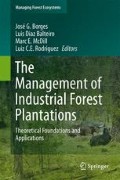Abstract
The chapter shows how mathematical modeling can help nursery managers to determine how, when, where and which seedlings to produce with increasing levels of productivity, specific mix of different genetic material, higher adequacy of clone-to-site levels and detailed planning for short time horizons. In a systematic approach, the mathematical techniques are presented as the problem becomes more complex. The strategy involves the use of an optimization mathematical planning model divided into nine components: (i) clonal garden production capacity; (ii) mini-stumps availability; (iii) mini-cuttings daily production capacity; (iv) nursery infra-structure; (v) time each clone takes to grow; (vi) matching potential productivity of clones to each planting area; and (ix) length of the planting period after the harvest. The focus is on how planting decisions and operations can be optimized once the manager has the harvesting schedule plan provided at the strategic level. The main decision variable is the starting period when a given set of clonal seedlings begins in the nursery to meet timely the planting needs. The objective is to maximize future production (wood volume or pulp tons). Planting areas are grouped according to soil, climate and other site characteristics to produce homogeneous planted stands. For each group, the optimal choice of clones, plantation density, fertilization levels, irrigation and other silvicultural practices are determined. The spatial distribution of different clones is considered to mitigate the risk of having few clones concentrated in large adjacent areas. The nursery usually starts the production of seedlings for a specific area close to the period of harvesting that area, matching the best clone seedlings to the recommendations prescribed by the forest manager. The model described in this chapter is illustrated by a real case example that synchronizes planting and harvesting in a large scale in Brazil. The optimal synchronization of nursery activities and silvicultural operations requires a detailed planning of all phases in the nursery and in the field. Linear programming techniques have sufficiently supported the integration of seedling production and nursery management, planting and harvesting. These are among the highest costs in any plantation forest budget.
Access this chapter
Tax calculation will be finalised at checkout
Purchases are for personal use only
References
ABRAF (2013) Year book statistical ABRAF. ABRAF, Brasília
Assis T, Resende M (2011) Genetic improvement of forest tree species. Crop Breed Appl Biotechnol 11 http://www.scielo.br/scielo.php?pid=S1984-70332011000500007&script=sci_arttext&tlng=es
Bae H, Seo Y (2007) BPM-based integration of supply chain process modeling, executing and monitoring. Int J Prod Res 45(11):2545–2566
Barros N, Novais R, Carmo DN (1986) Classificação nutricional de talhões florestais – descrição de uma metodologia. Revista Árvore 1:112–120
Brondani G, Wendling I (2012) Dynamics of adventitious rooting in mini-cuttings of Eucalyptus benthamii X eucalyptus dunni. Acta Scientiarum Agron 34(2):169–178
Challa H (2002) Crop models for greenhouse production systems. In: I. s. science (ed) Proceedings of the 4th international symposium on models for plant growth and control in greenhouses: modeling for the 21st century, Beltsville, MD, pp 47–53
Davis D (2003) The nursery management information system at J. Herbert Stone Nursery using MS Access. In: National proceedings: forest and conservation nursery associations 2002, Olympia, WA, pp 130–132
Fürst C, Vacik H, Lorz C, Makeschin F, Podrazky V, Janecek V (2007) Meeting the challenges of process-oriented forest management. For Ecol Manag 248:1–5
Oskarsson H, Brynleyfsdottir S (2009) The interaction of fertilization in nursery and field on survival, growth and frost heaving of birch and spruce. Iceland Agric Sci 22:59–68
Roberds J, Bishir J (1997) Risk analyses in clonal forestry. Can J For Res 27(3):425–432
Rosado A (2012) Seleção simultânea de clones de eucalipto de acordo com produtividade, estabilidade e adaptabilidade. Presquisa Agropecu Bras 47(7):964–971
Sadic R, Stock M, Wenny D, Robberecht R (1998) An expert system nursery management. AI Appl 12(1–3):41–50
Stage A (2003) How forest models are connected to reality: evaluation criteria for their use in a decision support. Can J For Res 33:410–421
Trkman P (2010) The critical success factors of business process management. Int J Inf Manag 10:125–134
Author information
Authors and Affiliations
Corresponding author
Editor information
Editors and Affiliations
Rights and permissions
Copyright information
© 2014 Springer Science+Business Media Dordrecht
About this chapter
Cite this chapter
Nobre, S.R., Rodriguez, L.C.E. (2014). Integrating Nursery and Planting Activities. In: Borges, J., Diaz-Balteiro, L., McDill, M., Rodriguez, L. (eds) The Management of Industrial Forest Plantations. Managing Forest Ecosystems, vol 33. Springer, Dordrecht. https://doi.org/10.1007/978-94-017-8899-1_11
Download citation
DOI: https://doi.org/10.1007/978-94-017-8899-1_11
Published:
Publisher Name: Springer, Dordrecht
Print ISBN: 978-94-017-8898-4
Online ISBN: 978-94-017-8899-1
eBook Packages: Biomedical and Life SciencesBiomedical and Life Sciences (R0)

